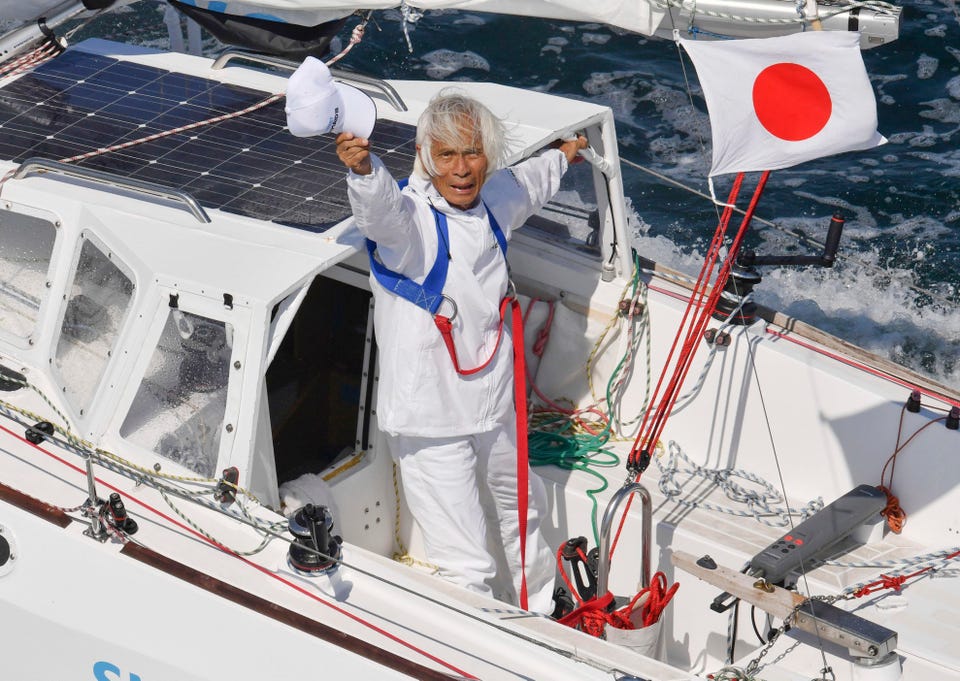Will One Man at Sea Shatter the Brand of Aged Japan?

Will One Man at Sea Shatter the Brand of Aged Japan?
Not only has Kenichi Horie crossed the entire Pacific Ocean in a small sailboat, he’s done it over and over for six decades. And when he did it again in 2022, he gave hope to the nation of Japan and its rapidly aging population: he spent over two months at sea and set a world record, while being just shy of his 84th birthday.
Brand Japan has been derided over recent years for its lagging economy and its rapidly aging and fading population. But eternal sailor Horie gave inspiration to Japan’s oldest generation, boarding his custom Mermaid III solar-powered yacht alone, pulling up anchor in the San Francisco Bay, and sailing under the Golden Gate bridge on a 60-day solo odyssey across the Pacific Ocean to his home port near Kobe, Japan.
His feat made headlines everywhere from California to Japan, boosting his messages of constant effort at any age and environmentally compatible transport, whether by sail, solar power or wave power. Each of his vessels have used natural power and repurposed materials.
Speaking at an event for ham radio operators some weeks after his Pacific crossing, Horie marched onto the stage with the energy of a teenager, and talked non-stop for an hour. Asked what his worst moments were during his crossing, he shook his head as if to ward off negative spirits. “I don’t wish to remember any of that” he said cryptically.
Later in his talk, he did admit to having some fears. The solar panels on the boat deck – which powered his radio, his Global Positioning System, his lights at night, and his microwave oven for heating ready meals – could not be taken for granted. Faced with several cloudy days in a row, the battery power would run low, and he wrestled with the creeping fear that he would lose the GPS, and not be able to navigate by stars through the cloudy nights. If his store-bought dry cell battery supply also ran out, he would essentially be left with only a compass in the middle of the ocean.
Horie’s first trans-Pacific adventure was in the days before GPS, and took him much longer to navigate. He crossed from Japan to San Francisco in 1962 at the age of 24, becoming the first person to sail non-stop solo from Japan to San Francisco. That adventure took a full three months of meandering before arriving at the Californian shore, where he was promptly arrested. As Horie joked, he was missing three necessary items: “No passport, no money, no English.”
Eventually he was released from jail, and as his story caught press attention, the mayor of San Francisco ended up giving Horie the ceremonial key to the city. It was a case of one sailor becoming a brand ambassador for an entire country, even though he was silent and penniless. He had to stay in San Francisco for weeks while trying to raise money to get back home.
Now an octogenarian, Horie told an enthralled crowd of seniors about the joys and dangers of being alone day and night in the open ocean. He saw pods of whales swimming close to his boat: a thrill to see yet a potential danger as the large cetaceans might collide with his 6-meter vessel.
On one trip a mast stay cable broke, and he had to climb the mast alone to fix it as the tiny vessel pitched and rolled in the ocean waves. Any fall from the mast onto the deck could cause him to be seriously injured, without anyone to provide first aid, signal for rescue, or take over the operation of the boat.
On another voyage crossing the South Pacific, he saw a boat approaching, and was afraid that it might be crewed by pirates wanting to steal his boat. He repeatedly ducked below deck, quickly changing his shirt and hat, and going up the other side of the boat while making more pointing and commanding gestures – he wanted to give the impression that there were several people on his boat in order to thwart any attack.
Horie seems to speak for his generation as well as younger generations with his trademark motto, translated roughly into English as: “Don’t let your dreams stay just dreams.”
That message could be communicated on a person level as well as a national level, as Japan is faces a national crisis of identity and demographic decline.
Horie’s record-setting adventures are against a backdrop of national decline in his home nation: Japan’s population has dropped from just over 128,000,000 in 2008-2010 to only 124,000,000 in 2021. The country that was once Asia’s tech powerhouse is now losing people at a rate of over 600,000 per year.
Even more startling is the aging of the remaining population: the median age is over 48.5. Entire industries such as agriculture and construction are facing a labor crunch because current workers are struggling to handle the demands of daily outdoor labor. Many are retiring and leaving without any younger workers to replace them. One study reported by Statista found that in 2020 the average farming worker in Japan was 67.8 years old.
Horie’s determination and achievements may not solve Japan’s difficult labor equation, but he is showing the world that elderly people have applicable skills, and inspiring millions of retired Japanese workers to pursue their post-retirement dreams.
This journal is for professionals and academic readers interested in Nation Branding, Place Branding, Ethnic Branding, and similar forms of politically-related communications and branding studies. The views expressed by the article authors are independent and do not necessarily reflect the views of Geobrands&Geopolitics editors.
